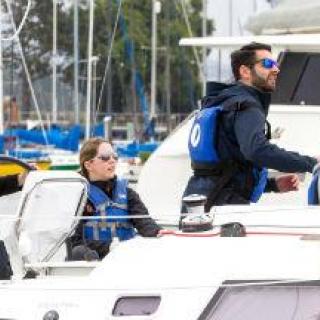Feeling your way through a maze while blindfolded, untangling your colleagues in a web of rope or searching the hidden contents of a container using paper clips probably aren’t the first things that come to mind when you think of resident wellness. Yet these are the exact activities that have improved the health and happiness of surgical residents in one innovative residency program. Learn more about how making time for certain activities is boosting productivity in training.
Authors of a recent editorial in JAMA discussed the compelling history and progress of Stanford University School of Medicine’s Balance in Life program, which started in 2010 after the tragic suicide of a recent graduate from the school’s general surgery training program.
“After mourning his loss only five months after having left Stanford, our residency program took decisive action to create a multifaceted program aimed at enhancing resident wellness,” the authors wrote.
“We first formed a committee consisting of residents and faculty. Through several meetings over the course of four months, we arrived at the structure of a Balance in Life program, now in its fourth year of implementation."
The program features a comprehensive curriculum based on four domains of wellbeing: professional, physical, psychological and social. Through activities and structured emotional and mental resources, residents learn how to strike work-life balance despite the inherent stressors of physician training.
Here are creative ways the program fosters wellness among residents:

Photos by Norbert von der Groeben / Stanford University School of Medicine
Providing resident mentorship and leadership training
To develop residents’ professional well-being, the program pairs junior residents with senior resident mentors. “Quarterly lunch meetings between the junior and senior pairs are funded by the program to facilitate an ongoing relationship. This provides junior residents a private, informal setting in which to discuss concerns about work, research or their personal lives,” the editorial said.
Participants in the Balance in Life program also receive leadership training through sessions that encourage residents to explore various leadership styles. For instance, one session used a rope course to focus on leadership, mutual support and team bonding. Another activity saw residents setting sail together in San Francisco Bay (pictured right) as part of a special sailing lesson designed to counter stress and boost team morale.
Stocking resident environments with healthy food and snacks
“A significant challenge our residents faced was the lack of healthy food options in the hospital, particularly in the evenings and on weekends. To solve this problem, we purchased a refrigerator that was placed in a secure location in our surgical education center, to which residents have badge access. The residents appreciate having a refrigerator that is stocked weekly with healthy drinks and snacks,” the authors wrote.
Offering residents resources that support their mental, emotional and physical health
While maintaining wellness is important, there often is a silent stigma around mental health in medicine that discourages seeking help. This is why the Balance in Life program offers residents confidential counseling as an integral part of training.
“One of the primary goals of the Balance in Life program is to provide residents with tools to manage stress in their lives. We enlisted an expert clinical psychologist with experience working with high-performance teams to meet with our residents weekly. These 90-minute confidential meetings are scheduled by postgraduate year on a rotating schedule, with each postgraduate-year group meeting with the psychologist every six weeks,” the editorial said. “This time is protected in the same way as weekly educational time, and topics are selected by the residents.”
Through these meetings, residents have collaborative discussions with peers and share positive coping strategies. They also are “encouraged and expected to see a physician annually and a dentist semiannually,” the editorial said. The program provides residents with a guide that lists physicians, dentists and physical-fitness venues recommended by their peers.
Hosting social gatherings and events
“We recognize the value of social well-being and its relationship with physical and psychological well-being. To this end, the Balance in Life program sponsors informal social gatherings such as happy hour, sports events and outdoor activities for promoting balance and mutual support among our residents,” the authors wrote.
Each year, the program appoints one or two residents to plan monthly social events, which “provide opportunities for residents and their families to spend time together away from the hospital. Faculty are also invited to a subset of these events, allowing for the development of meaningful relationships among residents and faculty,” the editorial said.
More well-being solutions and tips for residents
- Read how the Accreditation Council for Graduate Medical Education (ACGME) plans to foster resident wellness.
- See how you compare to your peers in a national wellness study from the ACGME.
- Educate yourself on the signs of burnout and how to avoid them.
- Review 5 things institutions can do to prevent resident burnout.
- Learn how other residents have conquered burnout in training.
- Get inspired with these 4 wellness solutions and ideas.






